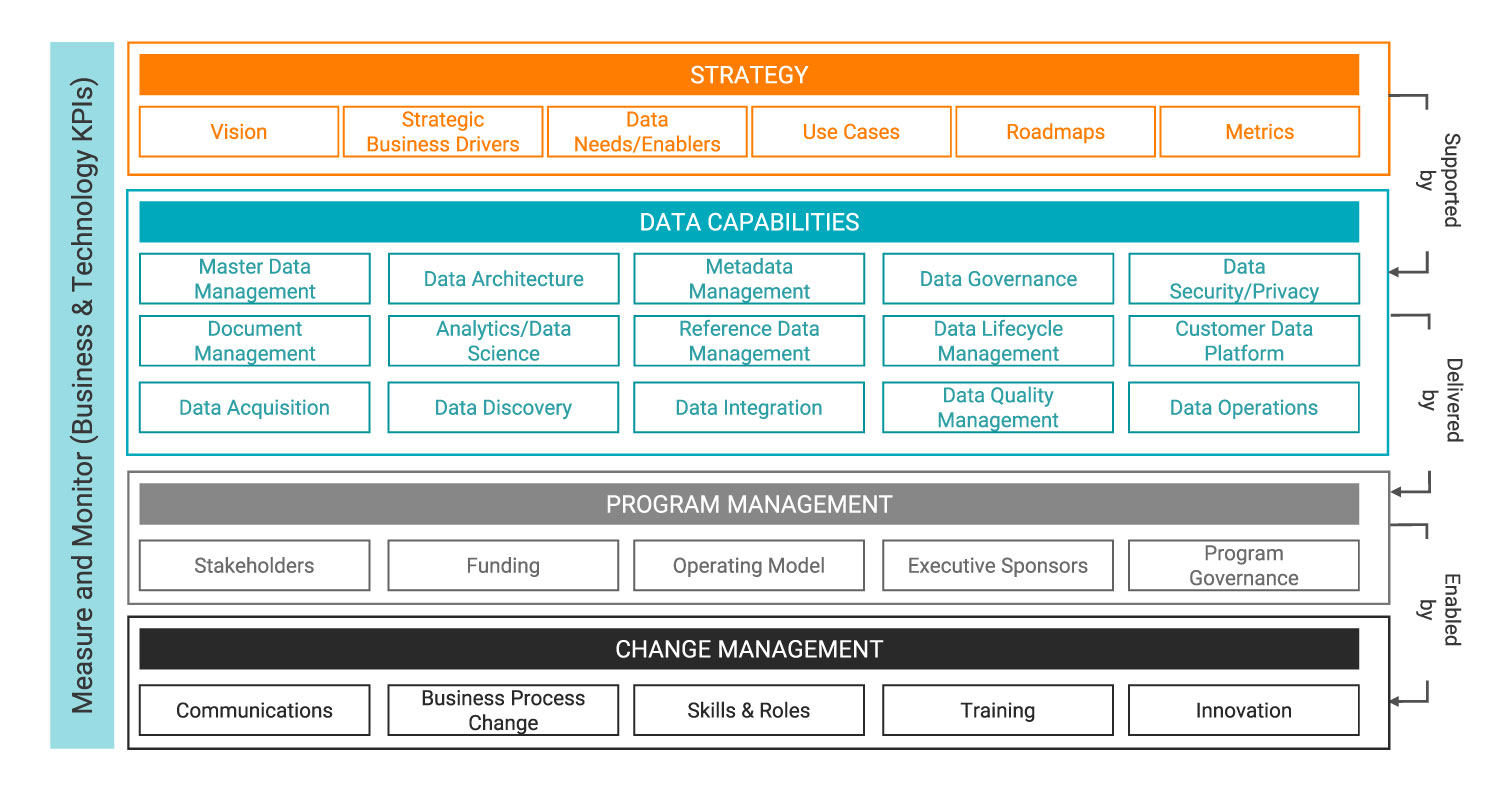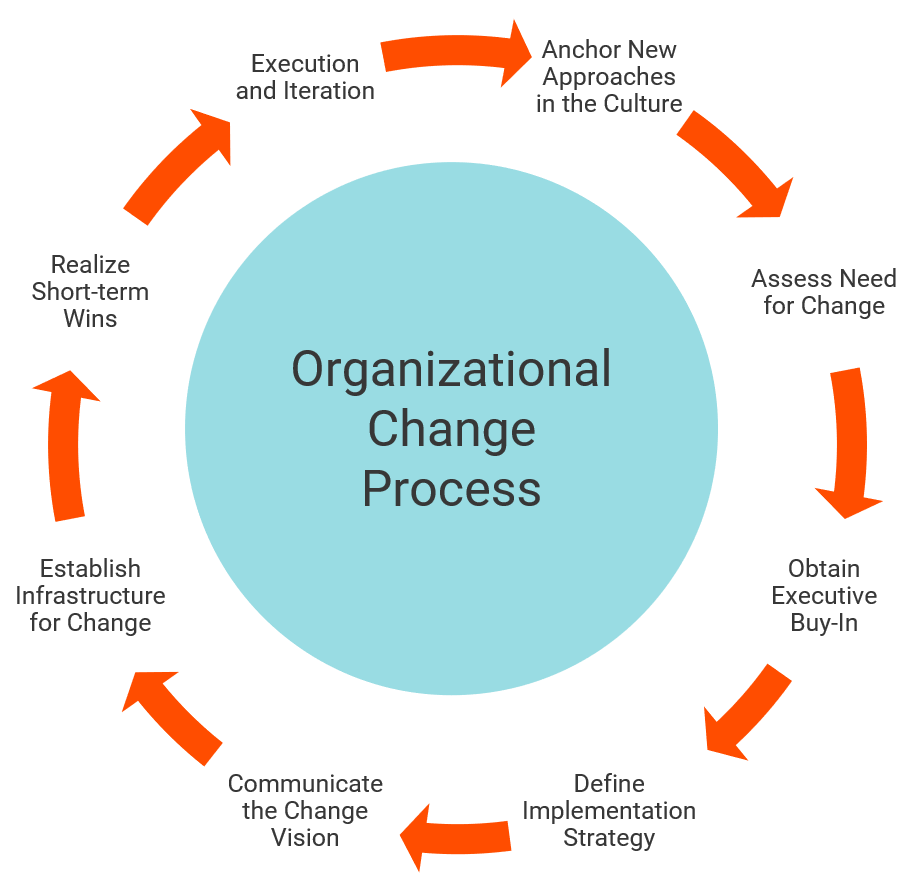As enterprises of all sizes find themselves challenged to modernize everything from applications to integrated systems and curated data lakes, they find themselves in a constant state of flux. Sometimes it feels like it’s an ‘all hands-on-deck’ exercise where it takes all of the available resources just to keep up! The pressure for continuous improvement and the buildout of new capabilities will probably never go away. Human beings--and therefore enterprises--will always be challenged with the need to change and improve, and indeed, our ultra-competitive marketplace demands responsiveness and agility. For this reason, Program and Change Management are important areas as an enterprise executes on their Data Strategy.
Program and Change Management techniques are critical to ensuring the success and sustainability of any data initiative--from Data Governance to a full-fledged Data Strategy. As more companies move their core operations and applications to the Cloud, formalized Change Management techniques will be critical in order to re-orient data stakeholders, systems administrators, system architects, and data management teams by introducing them to new technologies and the benefits of enhanced Cloud capabilities. As organizations introduce new processes and job expectations to support new technologies, we need to inform and educate our stakeholders on what to expect, how this will impact their current responsibilities and in what ways it introduces not only new analytics capabilities, but also new opportunities for communication and collaboration. As we undertake new strategic initiatives, we need to promote awareness and understanding so as not to disenfranchise those who will play key roles in adoption and business transformation. Change Management will be an ongoing part of what any organization going through the stages of modernization needs to introduce. It is vital to continuously engage with our user audiences throughout both the short-term and the long-term transformation.
Program Management is a quite different aspect of development than Change Management. In this article, we will explore how they are similar yet different, and we will introduce some of the types of resources, examples, best practices, and methodologies that can help support these ongoing activities.
Program Management
We think of Program Management as being focused on a specific goal, project or related set of projects, as opposed to ongoing Change Management. There are different types of approaches, including Agile, PMBOK, GANNT and others (SCRUM, PERT, Rational Unified Process, Kanban, etc.) and these each have very specific techniques for managing team resources and communications for the project itself. Typically, even for a long-term project, there is a specific start-date and end date. Resources engaged in the project are usually assumed to be fixed resources according to the timelines and specific activities detailed in the execution plan. As such, the accomplishments throughout the project will be measured against the milestones and timelines set out in the plan.
As detailed in the Informatica Data Strategy Framework (below), Program Management supports the tactical details required to build and develop new data management infrastructure: budget, project milestones, staffing, training, and project metrics. Change Management addresses the underlying organizational culture, power structures, need for communications, and coordination—all are essential for successful adoption of new technologies and capabilities.
Change Management
Any type of new program, whether it’s Data Governance, Data Strategy or another kind of strategic initiative will need to be elevated to the broader enterprise in regards to:
- Why it is being undertaken
- What is the business and operational value for the initiative
- How does it create value to those impacted
- How will it be monitored and measured to assess progress and ultimate success
Informatica has developed a Data Strategy framework that specifically calls out the importance of Program and Change Management as shown below:

Change Management consists of five critical activities that ultimately support Program Management, enable new Data Capabilities, and help the organization realize the vision and objectives of the Data Strategy itself. These activities include Communications, Business Process Change, Skills and Roles, ongoing Training, and Innovation. As a ‘best practice’, Informatica recommends the development of a formalized plan for each of these components so that the organization can monitor awareness, adoption, and strategic success over time.
Components of Managing Change
Managing Program Success
Change Management plans should address each of these eight key areas, since each is part of a holistic set of interdependencies as strategic change is introduced.
1. Inform users of the intended changes and the purpose/value of the changes
Change promotes insecurity. The more that data stakeholders understand the reason for introducing change the greater the degree that resistance is reduced. To successfully build a group of proponents, ensure that everyone understands their role as part of a team that is working towards a specific goal.
2. Let users know how changes will impact them—altered job expectations, relationships, leadership, skills.
Fear and insecurity play a big role in resistance to change. The more awareness and understanding can be developed, the more control stakeholders will feel they have in their future as well as om their ability to contribute to project success.
3. Design a comprehensive communications plan: audience, authorship, timing, medium (newsletter, website, etc.).
Strategic change takes time. Experience has shown that a primary factor in project success is sustaining awareness of ongoing project activities and success metrics. A communications plan will detail not just the first set of messages (objectives, kickoff events, roles, etc.) but the different types of messages that will need to come from different project stakeholders. Senior leadership needs to be vocal about the need for new investments and in broadcasting the ongoing business significance of the undertaking. Other key individuals will be responsible for updating stakeholders in upcoming milestones, achievements, and even ‘lessons learned’.
4. Explain the timing and timeline for changes—stages, milestones, metrics.
Stakeholders will need to be able to anticipate (and plan for) when key changes will occur and how they will be measured. This type of information can help build trust in program leadership and demonstrates through transparency that there will be no unexpected surprises.
5. Establish metrics to evaluate success of changes—determine baseline metrics and periodicity.
Ideally there will be a number of different metrics to consider including operational (process and engagement) and outcomes-related (improvements in data quality, standards, interoperability, etc.). Take the time to design a holistic set of measures and be sure to collect baseline data so that ongoing changes can be monitored.
6. Monitor progress and report on experience (success and failures, modifications, etc.).
“You cannot manage what you can’t measure.” All change initiatives will not necessarily be successful, but the stakeholders need to understand where success has been achieved and where it may have fallen short. Again, developing transparency in the process will help keep your stakeholders ‘on board’ over the long-term.
7. Announce any process or structural changes to modify going forward.
Even the best laid plans can’t anticipate real life experience. Build flexibility into the design and expect to modify it as more experience is gained. This includes processes, role descriptions, milestones, and even metrics. As experience builds with the day-to-day operations and culture, be willing to develop further where success occurs and let go of other ideas as necessary.
8. Continue ongoing monitoring and communication of results.
Communications are not ‘once-and-done’. Build into the execution plan the resources and processes to sustain regular, repeated communications to keep the interest of stakeholders and sponsors. Communications will ensure that successes don’t ‘evaporate’ amidst other change initiatives. Many organizations are suffering ‘change overload’. Try to avoid this by sharing clear progress and plans in an ongoing way so that key audiences don’t become exhausted.
Recommended Best Practice Methodology
Use the following best practice to design a comprehensive approach:
- Conduct an organization analysis that identifies the current situation, problems, and the forces that are a possible causes of those problems.
- Conduct an analysis of factors relevant to produce the needed change.
- Focus on who, why and how much
- Understand the relevant players and terms of power, trust, and modes of interaction
- Select an appropriate change strategy
- Monitor the progress of the strategy and modify accordingly
Organizations may use this tool when planning and implementing a change management initiative. The steps outlined combine Kotter’s Eight-Step Change Management Model with Change Management considerations uncovered in secondary literature.

Summary
As a society we are racing to keep up with new technologies, new markets, and new sources and types of data. The significant set of capabilities that Cloud technologies presents, as well as the need to modernize tools, governance processes, and skillsets, introduces potentially disruptive opportunities that may be met with resistance unless managed carefully. Project and Change Management address the significant gap between tools, processes, and technologies and their impact on people. Indeed, while new tools introduce exciting new opportunities, they also introduce the parallel need for an enterprise to rapidly change, from its very culture to how people view their day-to-day jobs.
Design Project and Change Management plans to include the behavioral modifications that will be critical to success: skillset development, team/organization structure, clearly defined roles and responsibilities, operational and outcomes-based metrics, and ongoing communications. Ultimately, it’s people that are data stakeholders and it is imperative to holistically develop their understanding and awareness of the need for changes and enlist their support and engagement along the way.





